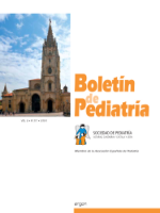Tratamiento combinado de la retención voluntaria de heces mediante fármacos y terapia ocupacional
I. Beaudry Bellefeuille , E. Ramos Polo
Bol. Pediatr. 2011; 51 (217): 169 - 176
Objetivo. Este trabajo presenta un enfoque terapéutico dirigido al tratamiento de la retención voluntaria de heces. Dicho enfoque combina la Terapia Ocupacional basada en la teoría de la Integración Sensorial (Ayres Sensory Integration-ASI®) con un tratamiento farmacológico prescrito por un pediatra de Atención Primaria o un gastroenterólogo pediátrico. Método. Los niños que no han respondido adecuadamente al tratamiento convencional son derivados al programa Peque-beque. Entre las estrategias básicas del tratamiento se encuentran actividades que proporcionan grandes cantidades de estímulo propioceptivo, estímulo de tacto profundo y/o vibración. Las adaptaciones para el uso del váter son realizadas de modo que tengan en cuenta las características sensoriales del niño. Resultados. En este programa ha participado un total de 12 niños; 7 varones, con edades entre los 26 meses y los 42 meses, y 5 niñas, con edades comprendidas entre los 26 meses y los 15 años. De ellos, 10 (83,33%) han experimentado una mejoría significativa; 5 (41,67%) de los niños han resuelto por completo sus dificultades de eliminación, y otros 5 (41,67%) mantienen la regularidad en la defecación, pero con un constante apoyo de sus cuidadores y una estricta rutina. Hay 2 niños (16,67%) que siguen mostrando una clara dificultad para regular su defecación. Conclusiones. Los resultados clínicos preliminares son esperanzadores y nos animan a seguir trabajando para profundizar y refinar los métodos de valoración y tratamiento para esta población.
Combined treatment of voluntary stool retention with drugs and occupational therapy
Objective. This paper presents a therapeutic approach for the treatment of voluntary stool retention. This approach combines occupational therapy based on sensory integration (Ayres Sensory Integration-ASI®) theory with a pharmacological treatment prescribed by a primary care paediatrician or paediatric gastroenterologist.
Methods. Children who have not responded adequately to conventional treatments are referred to the Happy Potty Program. Core treatment strategies include activities that provide large amounts of proprioceptive input, deep pressure input and/or vibration. Adaptations to the toilet arrangements are made taking into consideration the child’s sensory issues.
Results. A total of 12 children have participated in this program; 7 boys whose age ranged from 26 months to 42 months and 5 girls whose age ranged from 26 months to 15 years. Ten children (83,33%) have shown significant progress; 5 children (41,67 %) have completely resolved their stool retention problem and 5 children (41,67 %) maintain regular defecation but continue to need constant support fromtheir caregivers and adherence to a strict routine. Two of the children (16,67%) in the program continue to exhibit stool
regulation difficulties.
Conclusions. Preliminary clinical results are promising and encourage us to continue working in order to further refine evaluation and treatment methods for this population.
Artículo completo (PDF) (93 kb.)
- Gastroenterología
